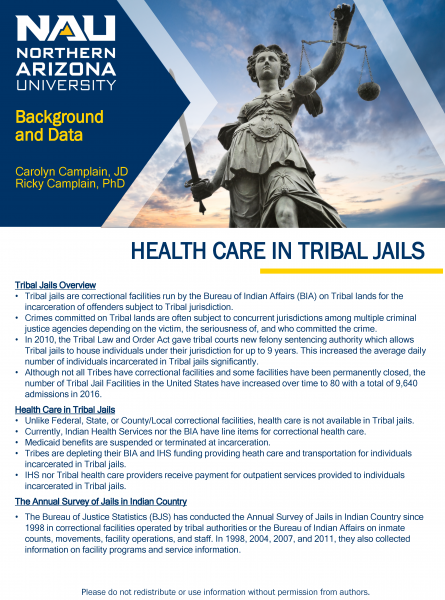CHER criminal justice contacts
Ricky Camplain, PhD
Carolyn Camplain, JD
Criminal justice and health equity

Incarceration in the United States, and all its burdens to families and the community, disproportionately affects lower-income communities, communities of color, and persons with disabilities, compounding preexisting barriers to achieving health equity (Camplain and Baldwin).
Nine million individuals cycle through the United States’ 3,200 jails (facilities that typically house individuals awaiting adjudication or serving sentences each year (Bai et al. 2015), almost triple the rate of incarceration compared to 30 years ago (Bureau of Justice Statistics 2012). Although the United States represents less than 5 percent of the world’s population, of the more than 10.7 million people held in correctional institutions throughout the world, almost 20 percent are in the United States (Walmsley 2018).

For these reasons and many others, the Center for Health Equity Research (CHER) is committed to addressing health equity issues in the local and national criminal justice system. Our collaborators include the Coconino County Detention Facility, the Criminal Justice Coordinating Council, and the NARBHA Institute. We also recently partnered with the National Academies of Sciences, Engineering and Medicine, specifically on their recent Roundtable on the Promotion of Health Equity entitled, “The Consequences of Juvenile Justice System Involvement on the Health and Well-being of Adolescents, Families and Communities of Color.”
As the United States seeks solutions to improve health equity in the criminal justice system, we must recognize that the jail system is a critical contributor to population health (Camplain and Baldwin).
References:
Bai, Jennifer R., Montina Befus, Dhritiman V. Mukherjee, Franklin D. Lowy, and Elaine L. Larson. (2015). Prevalence and Predictors of Chronic Health Conditions of Inmates Newly Admitted to Maximum Security Prisons. Journal of Correctional Health Care 21(3):255–264.
Camplain, Ricky and Julie A. Baldwin. (2019). Commentary: The Search for Health Equity among Individuals Incarcerated in Jail. Practicing Anthropology: Fall 2019, 41(4):46–48.
Walmsley, Roy. (2018). World Prison Population List. 12th ed. London, United Kingdom: Institute for Criminal Policy Research.
Health care in Tribal jails
Criminal Justice Coordinating Council partnership
 Since 2016, The Center for Health Equity Research (CHER) has partnered with the Criminal Justice Coordinating Council (CJCC) to study the Coconino County juvenile and criminal justice systems, especially in the areas of behavioral health and juvenile justice. The collaboration between CHER and the CJCC has helped them with their mission to “identify areas for improvement, and formulate policy, plans, and programs for change,” according to the CJCC website.
Since 2016, The Center for Health Equity Research (CHER) has partnered with the Criminal Justice Coordinating Council (CJCC) to study the Coconino County juvenile and criminal justice systems, especially in the areas of behavioral health and juvenile justice. The collaboration between CHER and the CJCC has helped them with their mission to “identify areas for improvement, and formulate policy, plans, and programs for change,” according to the CJCC website.
The partnership has resulted in more than a half dozen projects that have either been completed or are in progress.
Links to research publications Accordion Closed
Camplain R, Baldwin JA. Invited Commentary: The Search for Health Equity among Individuals Incarcerated in Jail Pract Anthropol. 2019 Sep; 41(4):46–48. https://doi.org/10.17730/0888-4552.41.4.46. PMCID: PMC7587468.
Camplain R, Baldwin JA, Warren M, Camplain C, Lininger M, Trotter RT. Physical activity among individuals incarcerated in jail: A social justice issue. J Phys Act Health. 2019 May 1; 16(5):306–307. https://doi.org/10.1123/jpah.2019-0055. PMCID: PMC7543228.
Camplain R, Becenti L, Pinn TA, Williamson H, Pro G, Luna C, Bret J. Patterns of Physical Activity among Women Incarcerated in Jail. J Correct Health Care. In Press.
Camplain R, Camplain C, Trotter, RT, Pro G, Sabo S, Eaves E, Peoples M, Baldwin JA. Racial/Ethnic Differences in Drug- and Alcohol-Related Arrest Outcomes in a Southwest County from 2009-2018. Am J Public Health. 2020 Jan; 110(S1):S85–S92. https://doi.org/10.2105/AJPH.2019.305409. PMICD: PMC6987943.
Camplain R, Pinn TA, Williamson H, Pro G, Becenti L, Bret J, Luna C, Baldwin JA. Adaptation of the System for Observing Play and Recreation in Communities (SOPARC) for the Measurement of Physical Activity in Jail Settings. Int J Environ Res Public Health. 2020 Jan; 17(1):349. https://doi.org/10.3390/ijerph17010349. PMCID: PMC6981919.
Camplain R, Warren M, Baldwin JA, Camplain C, Fofanov VY, Trotter RT. Epidemiology of incarceration: Characterizing jail incarcerations in Coconino County for public health research. Epidemiology. 2019 July 1; 30(4):561-568. https://doi.org/10.1097/EDE.0000000000001021. PMCID: PMC6559241.
Camplain R, Warren M, Baldwin, JA, Camplain, C, Fofanov, Viacheslav Y, Trotter, RT II. Epidemiology of Incarceration for Public Health Research Epidemiology: July 2019 – Volume 30 – Issue 4 – p 561–568.
Camplain R, Williamson HJ, Pinn TA, Shuman S, Robinson BM, Evans M, Luna C. Barriers and Facilitators to Attending and Being Physically Active During Recreation Time Among Women Incarcerated. BMC Womens Health. 2022, 22(1):239. doi: 10.1186/s12905-022-01831-w.
Eaves ER, Kohlbeck B, and Camplain C. Reflexive Challenges in Community Engaged Research in a County Jail
Eaves E, Camplain R, Lininger M, Trotter RT. Adverse Childhood Experiences in relation to drug and alcohol use in 30 days prior to incarceration in a county jail. Int J Prison Health. 2020 Nov. Online ahead of print. https://doi.org/10.1108/IJPH-06-2020-0038
Fofanov V, Hepp C, Cocking J, and Trotter II RT. Overcoming Institutional, Scientific, and Cross-disciplinary Barriers for Healthcare and Disease Transmission Research in County Jail Settings: Integrating Genomics, Survey Data, and Biological Data Collection Strategies
Hepp C, Fofanov V, and Trotter II RT. Organizational and Institutional Compartmentalization as a Barrier to Population Health
Pinn T, Williamson H, Robinson B, Shuman S, Evans M, Pro G, Camplain R. “Everything has changed”: Detention Officer Roles and Recreation Time Changes Due to COVID-19 Policies at a Southwest County Jail. Health Justice. 2022, 10(1):18. doi: 10.1186/s40352-022-00181-x.
Pro G, Camplain R, Lea CH III. The Competing Effects of Racial Discrimination And Racial Identity On The Predicted Number of Days Incarcerated in The US: A National Profile of Black, Latino/Latina, And American Indian/Alaska Native Populations. PLoS ONE 2022, 17(6): e0268987.
Pro G, Camplain R, Sabo S, Baldwin JA, Gilbert PA. Substance abuse treatment in correctional versus community settings: Analysis of racial/ethnic and gender differences. J Health Dispar Res Pract. 2018; 12(3), p.1. https://doi.org/10.1007/s40615-019-00696-4.
Trotter II RT, Camplain R, Eaves E, Fofanov V, Dmitrieva N, Hepp H, Warren M, Barrios B, Pagel N, Mayer A, and Baldwin JA. Health Disparities and Converging Epidemics in Jail Populations: Protocol for a Mixed-Methods Study JMIR Res Protoc. 2018 Oct 24;7(10):e10337.
Trotter RT, Fofanov VY, Camplain R, Arazan C, Camplain C, Eaves E, Hanabury, M, Hepp C, Kohlbeck B, Lininger M, Peoples IM, Traustadottir T, Dmitrieva NO, Baldwin JA. Health Disparities in Jail Populations: Mixed Methods and Multi-Disciplinary Community Engagement for Justice and Health Impacts. Pract Anthropol. 2019 Sep; 41(4):2–16. https://doi.org/10.17730/0888-4552.41.4.2. PMCID: PMC7587465.
Trotter II RT, Lininger M, Camplain R, Fofanov V, Camplain C, and Baldwin JA. A Survey of Health Disparities, Social Determinants of Health, and Converging Morbidities in a County Jail: A Cultural-Ecological Assessment of Health Conditions in Jail Populations Int J Environ Res Public Health. 2018 Nov 8; 15(11):1–16.
Links to media features on CHER criminal justice activities Accordion Closed
- NAU researchers partner with Coconino County Attorney’s Office to develop criminal justice deflection and diversion infrastructure
- Camplain featured on Radio Bilingüe
- C. Camplain awarded scholarship to correctional health policy conference
- Anthropology journal highlights work of NAU researchers with focus on criminal justice, population health

